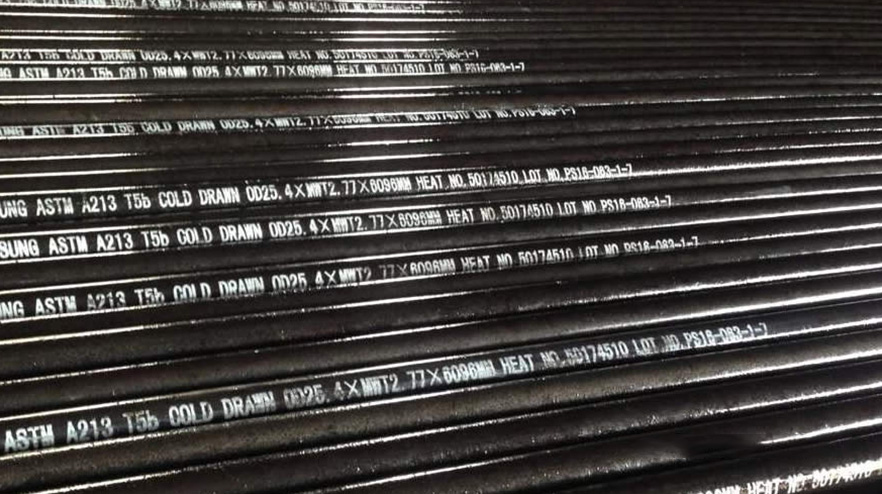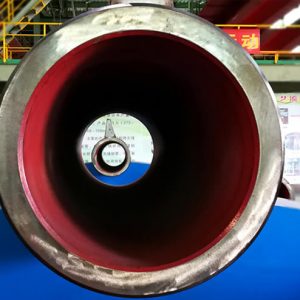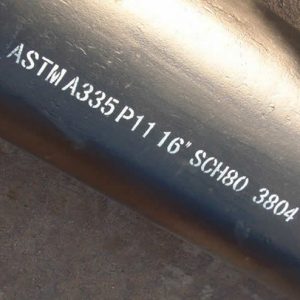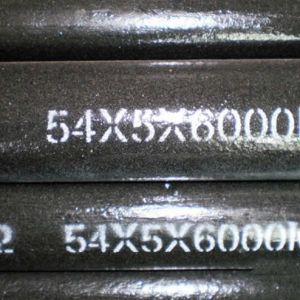These different requirements provide higher creep-rupture strength than normally achievable in similar grades without these different requirements. ASTM A213 T5b tubes shall be made by the seamless process and shall be either hot finished or cold finished, as specified. Grade TP347HFG shall be cold finished. Heat treatment shall be done separately and in addition to heating for hot forming. The ferritic alloy and ferritic stainless steels shall be reheated. On the other hand, austenitic stainless steel tubes shall be furnished in the heat-treated condition. Alternatively, immediately after hot forming, while the temperature of the tubes is not less than the minimum solution temperature, tubes may be individually quenched in water or rapidly cooled by other means. Tension test, hardness test, flattening test, and flaring test shall be done to each tube. Also, each tube shall be subjected to the nondestructive electric test or hydrostatic test.
Mechanical Properties for ASTM A213 T5b Low Alloy Steel
– ASTM A213 Grade T5b Alloy Steel Seamless Tubes are Carbon Steel Tubes with subsequent addition of chromium, molybdenum and sometimes vanadium are known as chrome moly Tubes.
– ASTM Specification Alloy Steel Tubes are used for high temperature service applications. Seamless Alloy Steel Tubes according to ASTM A213 Grade T5b are reheated and furnished in full annlealed, isothermal annealed or normalised quenched and tempered condition.
– ASTM A213 Grade T5b Alloy Steel Seamless Tubes have a typical chemistry with additions of 4.00-6.00 Chromium and 0.45-0.65 Molybdenum. Bearing minimum tensile strength of 415 Mpa ASTM A213 Grade T5b Tubes have a minimum yield strength of 205 Mpa.
This abstract is a brief summary of the referenced standard. It is informational only and not an official part of the standard; the full text of the standard itself must be referred to for its use and application. ASTM does not give any warranty express or implied or make any representation that the contents of this abstract are accurate, complete or up to date.
Chemical Composition(%) for ASTM A213 T5b Low Alloy Steel
UNS Designation K41545
Carbon 0.15
Manganese 0.30–0.60
Phosphorus 0.025
Sulfur 0.025
Silicon 1.00-2.00
Nickel …
Chromium 4.00-6.00
Molybdenum 0.45-0.65
Vanadium …
Boron …
Niobium …
Nitrogen …
Aluminum …
Tungsten …
Other Elements …
Mechanical Properties for ASTM A213 T5b Low Alloy Steel
Tensile strength(min) 415Mpa
Yield strength(min) 205Mpa
Elongation 30%
Hardness, HB 179 max
Permitted Tolerance for OD
OD Plus tolerance(+) Minus tolerance (-)
10.29—48.3 0.4 0.4
<48.3—-≤114.3 0.79 0.79
<114.3—≤219.1 1.59 0.79
<219.1—≤323.9 2.38 0.79
<323.9 ±1%
Equivalent Designation DIN EN BS NFA ASTM ASME
– EN X11CrMo5
Grade 10216 – 2 – ASTM A213 Grade T5b ASME SA 213 Grade T5b UNI 17102
ASTM A213 T5b Standard Scope 1.1 This specification covers seamless ferritic and austenitic steel boiler, superheater, and heat-exchanger tubes, designated Grades T91, TP304, etc. These steels are listed in Tables 1 and 2.
1.2 Grades containing the letter, H, in their designation, have requirements different from those of similar grades not containing the letter, H. These different requirements provide higher creep-rupture strength than normally achievable in similar grades without these different requirements.
1.3 The tubing sizes and thicknesses usually furnished to this specification are 1/8 in. [3.2 mm] in inside diameter to 5 in. [127 mm] in outside diameter and 0.015 to 0.500 in. [0.4 to 12.7 mm], inclusive, in minimum wall thickness or, if specified in the order, average wall thickness. Tubing having other diameters may be furnished, provided such tubes comply with all other requirements of this specification.
1.4 The values stated in either SI units or inch-pound units are to be regarded separately as standard. Within the text, the SI units are shown in brackets. The values stated in each system may not be exact equivalents; therefore, each system shall be used independently of the other. Combining values from the two systems may result in non-conformance with the standard. The inch-pound units shall apply unless the “M” designation of this specification is specified in the order.
TABLE 1 Chemical Composition Limits, %A, for Low Alloy SteelA Maximum, unless range or minimum is indicated. Where ellipses (…) appear in this table, there is no requirement, and analysis for the element need not be determined or reported. B It is permissible to order T2 and T12 with a sulfur content of 0.045 max. See 16.3. C Alternatively, in lieu of this ratio minimum, the material shall have a minimum hardness of 275 HV in the hardened condition, defined as after austenitizing and cooling to room temperature but prior to tempering. Hardness testing shall be performed at mid-thickness of the product. Hardness test frequency shall be two samples of product per heat treatment lot and the hardness testing results shall be reported on the material test report.




